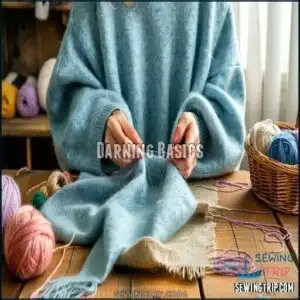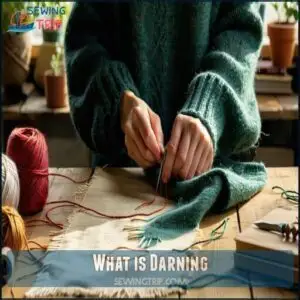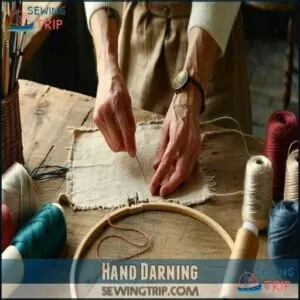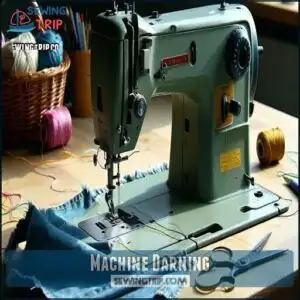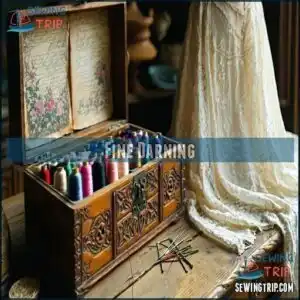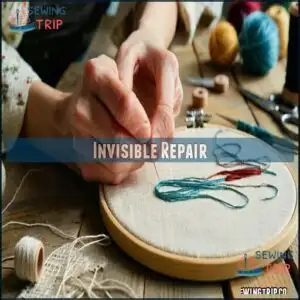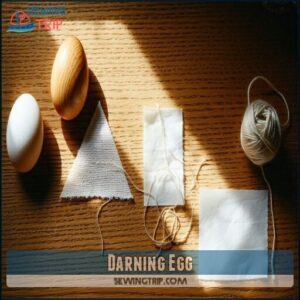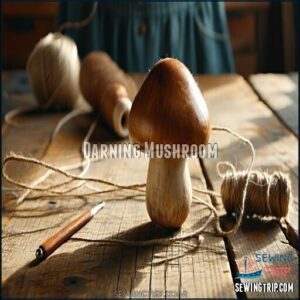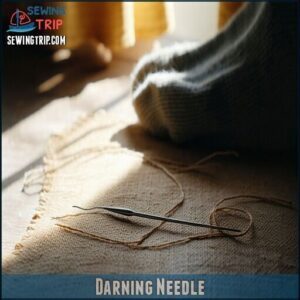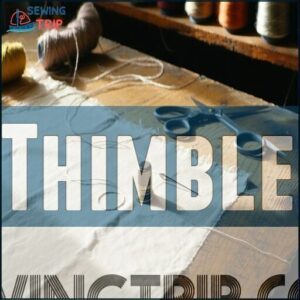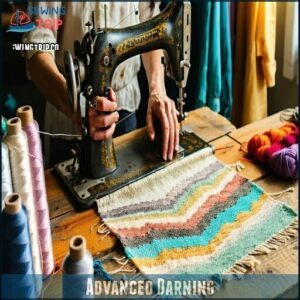This site is supported by our readers. We may earn a commission, at no cost to you, if you purchase through links.
 Darning is your fabric rescue mission! You’ll weave threads across holes and worn spots, creating a sturdy new surface that brings damaged clothes back to life.
Darning is your fabric rescue mission! You’ll weave threads across holes and worn spots, creating a sturdy new surface that brings damaged clothes back to life.
Think of it as fabric surgery – you’ll use a specialized technique where you create a grid-like pattern of threads that mimics the original fabric’s weave.
It’s not just about fixing clothes; it’s about saving money and reducing waste. Whether you’re dealing with a tiny sock hole or a larger tear in your favorite sweater, darning lets you patch things up like a pro.
And the best part? With a bit of practice, you’ll turn those wear-and-tear moments into textile triumphs.
Table Of Contents
Key Takeaways
- You’ll transform damaged clothes from trash to treasure by using darning, a technique that weaves threads across holes to recreate the fabric’s original structure and restore its strength.
- You’ll save money and reduce textile waste by extending your garments’ lifespans through strategic mending, turning potential clothing casualties into sustainable fashion opportunities.
- You’ll master different darning techniques ranging from hand darning to machine darning, with tools like darning eggs and needles that help you create seamless, nearly invisible repairs on various fabric types.
- You’ll elevate fabric repair from a simple fix to an art form, using decorative stitches and creative weaving patterns that not only mend holes but also add unique aesthetic value to your clothing.
Darning Basics
Ever wondered how to rescue your favorite sweater with a gaping hole or those comfy socks on the verge of becoming rags?
Breathe new life into worn fabrics with a needle, thread, and a dash of textile magic—darning transforms trash into treasure.
Darning is your secret sewing superpower that lets you mend, strengthen, and breathe new life into worn-out clothes, saving you money and reducing waste with just a needle, thread, and a bit of patience, which is a great way to practice darning.
Definition and Purpose
Darning is your secret superpower for rescuing beloved fabrics from the brink of destruction.
This ingenious sewing technique transforms tattered textiles by weaving magic right into the worn spots.
Why should you care?
- Saves your favorite clothes from the trash
- Restores fabric’s original strength and integrity
- Creates invisible repairs that look professionally done
Your textile restoration journey starts here – no sewing superhero cape required, and it’s a great way to achieve professional results!
History and Origins
When resourceful ancestors patched threadbare clothing, they birthed a remarkable fabric restoration art. Darning emerged from necessity, transforming textile preservation into a cultural craft passed through generations.
Here’s a glimpse into its fascinating journey:
| Era | Cultural Origin | Significance |
|---|---|---|
| Ancient | Egypt | Early Mending Techniques |
| Medieval | Europe | Survival Skill |
| Industrial | England | Domestic Economy |
| Pre-Modern | Japan | Artistic Expression |
| Modern | Global | Sustainable Practice |
Textile historians celebrate this ingenious traditional method that turns worn fabrics into treasured, restored pieces, highlighting the importance of textile preservation and cultural craft in a world where darning is a valued skill.
Benefits of Darning
After tracing darning’s rich history, you’ll discover it’s more than a nostalgic craft—it’s your wardrobe’s secret superhero.
Fabric preservation meets budget-friendly magic, transforming worn-out clothes into treasured pieces.
With invisible mending techniques, you’ll extend garment lifespans, save money, and reduce textile waste.
It’s sustainable fashion that looks good, feels smart, and keeps your favorite items in rotation longer.
What is Darning
Ever patched up a favorite sweater that’s seen better days? Get ready to meet your clothing’s superhero: darning. It’s more than just a simple sewing repair—it’s a fabric-saving magic trick that breathes new life into worn-out threads.
Here’s what makes darning incredible:
- Restores damaged fabric by recreating its original weave
- Uses strategic thread placement to rebuild fabric structure
- Works on everything from delicate knits to sturdy denim
- Transforms holes from fashion disasters into creative opportunities
Unlike traditional mending, darning techniques blend seamlessly with your garment’s original fabric. It’s like fabric forensics, where you’re reconstructing lost fibers with precision and care. Sewing repair becomes an art form, turning potential clothing casualties into stories of resilience and resourcefulness.
To achieve professional results, understanding the role of a darning plate tool is essential for free-motion embroidery and quilting projects.
Darning Techniques
Ready to rescue your favorite clothes from the brink of retirement?
Master the art of darning techniques, and you’ll transform those worn-out threads into fabric phoenixes rising from the mending pile, giving your beloved garments a second chance at life.
This approach will help you breathe new life into your old clothes, making them beloved garments once again.
Hand Darning
Right up your alley, hand darning transforms worn clothes into treasures with just a needle and thread. Master this ancient craft and breathe new life into your favorite garments.
| Tool | Purpose |
|---|---|
| Darning Needle | Precise fabric piercing |
| Embroidery Hoop | Fabric tension control |
| Thread | Matching fabric restoration |
| Darning Egg | Surface stabilization |
| Thimble | Finger protection |
Your sewing repair skills will reveal fabric mending magic, turning holes into invisible art with carefully woven darning stitches. This will help you achieve fabric restoration with ease.
Machine Darning
After mastering hand darning, you’ll love how machine darning speeds up fabric restoration.
Your sewing machine becomes a repair superhero, using a special darning foot to weave threads seamlessly across holes.
With zero-length stitches and slow fabric guidance, you’ll tackle rips in everything from denim to tank tarpaulins quickly and professionally.
Fine Darning
Fabric lovers’ secret weapon, fine darning elevates mending from a simple repair to an art form.
With precision thread selection and intricate stitch patterns, you’ll weave magic into worn garments.
Expert darning techniques transform holes into invisible repairs, breathing new life into cherished textiles.
It’s more than fixing—it’s fabric resurrection that saves money and preserves memories.
Invisible Repair
With nimble fingers and a keen eye, invisible darning transforms damaged fabric into a flawless canvas.
Your fabric repair toolkit should include:
- Color-matched thread
- Fine darning needle
- Embroidery hoop
- Sharp scissors
- Steady patience
Weave repair becomes an art form, seamlessly fixing holes using precise sewing techniques that blend stitches into the original fabric’s texture.
Master this skill, and no garment is beyond salvation.
Darning Tools
Want to become a darning pro? Grab your darning egg, mushroom, and needle, and you’ll be saving your favorite clothes from the trash heap in no time!
Darning Egg
When repairing fabric, your secret weapon might just be the humble darning egg. These egg-shaped darning aids create perfect fabric tension, making weaving techniques smoother than ever.
Check out how different darning eggs stack up:
| Material | Size | Best For |
|---|---|---|
| Wood | Small | Socks |
| Ceramic | Medium | Sweaters |
| Plastic | Large | Delicate Fabrics |
The right darning egg can transform your yarn selection and repair skills from amateur to pro. Understanding darning egg tools is essential for achieving professional results.
Darning Mushroom
Your trusty darning mushroom is like a secret weapon in your fabric repair arsenal.
This wooden or plastic tool holds fabric taut while you weave magic with your darning needle.
Different mushroom types come in various sizes, helping you tackle holes in everything from delicate socks to sturdy denim.
It’s your go-to companion for seamless, professional-looking fabric repairs.
When working with sewing machines, understanding darning plate functions is essential for efficient repairs.
Darning Needle
Whether you’re patching a favorite sock or rescuing a cherished sweater, your darning needle is the unsung hero of clothing repair.
This slender tool is your secret weapon for mending magic, bridging fabric gaps with precision and skill.
When selecting the right darning needle, consider the Darning Needle options available for different projects.
- Extra-long with a large eye for thick threads
- Comes in sizes 14-18 for different fabric weights
- Sharp point glides smoothly through delicate weaves
- Typically made of steel for durability and strength
Thimble
Metal shields for your fingertips, thimbles are a darning superhero’s secret weapon.
Protecting your digits from needle pricks, these tiny armor pieces come in various materials and sizes to suit every needlework adventure.
When shopping for thimbles, consider the importance of a good sewing thimble.
| Material | Best For |
|---|---|
| Brass | Heavy fabrics |
| Silver | Delicate sewing |
| Leather | Comfort grip |
They’re not just finger guards—they’re precision tools that make sewing techniques smoother and more controlled, providing a comfort grip and serving as tiny armor.
Darning Applications
You’ve got a superhero skill in darning that can breathe new life into your worn-out clothes and save you serious cash.
Whether you’re patching up a favorite pair of socks or rescuing a treasured sweater from the brink of destruction, darning lets you extend your wardrobe’s lifespan with just a needle, thread, and a bit of creativity.
Fabric Preservation
After mastering your darning tools, you’ll discover the art of fabric preservation—a skill that breathes new life into worn textiles.
Weave restoration isn’t just about fixing holes; it’s about protecting your favorite pieces from premature retirement.
By reinforcing fibers and strengthening vulnerable areas, you’re extending the lifespan of cherished garments through strategic textile repair, which is essential for fabric preservation.
Cost-Effective
In budget-friendly fabric repair, darning is your wallet’s best friend.
With just a needle and thread, you’ll save big on replacing clothes.
Frugal mending lets you breathe new life into worn garments, cutting clothing costs dramatically.
Those tiny holes? They’re now opportunities for cost-effective textile conservation that keep more money in your pocket.
Eco-Friendly
Right in the middle of the sustainable fashion movement, darning emerges as your ultimate eco-warrior technique.
By repairing instead of replacing, you’re championing green living through fabric recycling.
Here’s how darning supports zero waste:
- Dramatically reduces textile waste
- Extends clothing lifespan dramatically
- Minimizes environmental consumption footprint
Your simple needle and thread become powerful tools in upcycling, transforming damaged garments into treasured, revived pieces with minimal environmental impact.
Aesthetics
Beyond saving your favorite threads, darning becomes a canvas for textile artistry.
Your repair transforms ordinary mending into decorative stitching—a visual playground where color choice and pattern making breathe new life into worn fabric.
Imagine turning a sock hole into an embroidery masterpiece or giving your jeans a unique fabric texture that tells your personal style story.
To achieve professional-looking results, understanding the importance of stretchy fabric stabilization is essential for a durable and long-lasting repair.
Advanced Darning
Buckle up for the darning world’s advanced playground, where you’ll transform simple repairs into textile art.
You’ll learn mind-blowing techniques like twill and chevron weaves that’ll have your clothes looking so good, no one will believe they were once destined for the trash heap.
Twill Weave
A thread’s journey through fabric reveals the magic of twill weaving in darning.
Twill patterns transform your repair game with their distinctive diagonal lines and sturdy structure.
Consider how these weaves breathe new life into your favorite garments:
- Diagonal threads create strength
- Unique texture mimics original fabric
- Flexible weaving technique
- Seamless integration of repair
Twill darning isn’t just mending—it’s fabric resurrection, turning worn threads into a canvas of resilience.
Chevron Weave
A clever chevron weave transforms darning from a mundane repair technique into a textile art form.
You’ll create stunning diagonal lines that dance across fabric, reinforcing holes with stylish precision.
By mastering this weaving pattern, you’ll strategically repair garments while adding visual interest.
Chevron patterns turn simple fabric repair into a creative expression that saves your favorite clothes, making it a valuable skill to master for textile art.
Decorative Stitches
From the chevron’s sharp angles, you’ll discover a world of decorative darning magic!
Spice up your mending with these stitch variations:
- Pattern Darning: Geometric playground of threads
- Embroidery Stitches: Artistic repair transformations
- Weave Techniques: Structural visual storytelling
- Thread Colors: Vibrant repair landscapes
- Embellishments: Turning damage into design
Master decorative mending and turn holes into haute couture with creative darning techniques that speak volumes about your craftsmanship!
Understanding advanced embroidery stitches is essential for achieving professional-looking results in darning.
Darning on Delicate Fabrics
After adding artistic flare with decorative stitches, you’ll want precision for silk repair and wool mending.
Delicate fabrics demand gentle handling and smart techniques.
Check out this quick guide to fabric tears and invisible darning:
| Fabric Type | Best Needle | Thread Choice | Repair Approach |
|---|---|---|---|
| Silk | Size 10-12 | Fine silk thread | Loose, gentle stitches |
| Lace | Thin embroidery | Matching color | Minimal tension |
| Cotton | Size 9-11 | Lightweight cotton | Small, even darns |
| Wool | Fine darning | Wool blend | Careful weaving |
The table provides a summary of the best approaches for different fabric types, including silk and wool, to ensure a successful repair.
Frequently Asked Questions (FAQs)
What is a darning stitch?
When push comes to shove, a darning stitch is your fabric’s best friend.
You’ll weave parallel stitches back and forth, mimicking the original weave to seamlessly repair holes and strengthen worn areas in your beloved garments, which is a seamless way to extend the life of your clothing.
What is darning in sewing?
You’ll love darning—a crafty sewing technique that mends fabric holes by weaving threads to recreate the original weave.
It’s like giving your worn clothes a second life, strengthening and restoring them with minimal fuss and maximum skill.
What is a darning needle?
You’ll want a darning needle for mending fabric—it’s longer, thicker, and has a larger eye than standard sewing needles.
Perfect for weaving threads through holes and creating seamless, sturdy repairs on your favorite garments.
What is darning in knitting?
When dropped stitches threaten to unravel your cherished knit, darning swoops in like a fabric superhero.
You’ll weave new threads through damaged areas, recreating the original knit pattern and rescuing your beloved garment from the brink of destruction, utilizing a technique that can be seen as a form of fabric rescue, where darning plays a crucial role.
How to do pattern darning?
Learn pattern darning by creating geometric designs with running stitches.
Start with simple, evenly spaced rows. Vary stitch lengths to craft unique patterns.
Choose contrasting threads for visual impact, and practice on scrap fabric first to ensure the best results with geometric designs.
What is darning a sock?
Darning a sock is like weaving a lifeline back into your favorite footwear.
You’ll carefully stitch over worn spots, recreating the fabric’s original texture and strength, turning holes into nearly invisible mends, which is essentially recreating the fabric.
What are the 4 types of darning?
You’ll master four darning techniques: straight, diagonal, pattern, and Swiss.
Each method repairs fabric differently, letting you transform worn-out clothing into personalized, resilient pieces that tell a unique story of care and creativity.
These techniques allow you to repair fabric in various ways, making each piece unique and special.
How to darn for beginners?
Grab a darning needle, matching thread, and an embroidery hoop.
Start with simple repairs on scrap fabric. Practice weaving stitches across holes, mimicking the original weave.
Take your time and be patient with yourself.
What does a darning stitch look like?
A darning stitch looks like a web of parallel lines woven back and forth across a hole, mimicking the fabric’s original weave.
You’ll create a grid-like pattern that blends seamlessly, repairing the damaged area with precise, close-set threads, using a technique that involves a web of parallel lines.
How to do darning on a sewing machine?
You’ll need a free-motion presser foot and darning foot to machine darn.
Lower your feed dogs, adjust stitch length to zero, and carefully guide fabric under the needle, creating a woven patch over the hole.
Conclusion
Think of darning as your textile first-aid kit, patching up wardrobe wounds with finesse.
Mastering what’s darning isn’t just a skill—it’s a money-saving, eco-friendly superpower that transforms worn garments into renewed treasures.
You’ll extend your clothes’ life, reduce waste, and feel like a repair superhero.
Whether you’re a beginner or a seasoned stitcher, darning empowers you to rescue beloved pieces and create something uniquely sustainable.
Your wardrobe will thank you!

